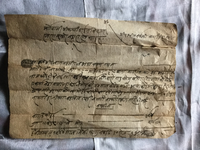A document from Dalāna Tahasila Aḍḍā acknowledging receipt for an emolument from Pāro Gāũ (VS 1944)
ID: Tsum_0001_0012
Edited and
translated by Nadine Plachta and Rajendra Shakya
Created: 2017-07-17;
Last modified: 2020-01-11
For the metadata of the document, click here
The accompanying edition, translation/synopsis and/or commentary are available under the terms of the Creative Commons Attribution-ShareAlike 4.0 International License
Abstract
This document deals with the obtainment of payment in cash and kind for the emolument from Pāro Gāũ in Aṭhāra Saya Kholā that was granted to the Commanding General of the Western Front, Raṇa Śamśera, who, by the time this payment was made, had apparently passed away.Diplomatic edition
[1r]
1श्री\1स्वर्गेवासीश्रीकम्यांदरईनचिफजन2रलरणसम्सेरजङ्गराणावहादुर
3१1श्रीपश्चीम्तर्फकोकम्यांडीङ्जनरल
2२[Unknown seal]1स्वस्तिश्रीदलान्तहसी∙लअडाकस्यपत्रम्--- ---- --- --- ---- --- --- ---- ---
2आगेदाषीलाआम्दानी∙¯ ¯१¯साहेवका¯ ¯२¯खान्गीमादरीय़ाको∙षुवाअठारसैषो
3लामध्येदोचेतर्फस्यार∙पट्टीपाचय़ार्वाको∙पारोगाउकोमुषीय़ा∙रीगमागवोकाछो
4राकर्माजेठापासाल्हार्क्यालनोर्वुको४४सालकाठेकमध्ये∙आय़ाकोहस्तेदाव़ादुंदुलेस्ही
5छापगरीवुझाय़ाको∙ज्मामोहरुचारसैचाररुपैञातेह्रआना∙नौदाम४०४ ||| /|| १दीठ्ठा
6नरवाहादुरजीम्मा∙तहविलदाषीलभय़ोतस्को∙रसीदगरीदीञ्यूं-------
7तप्सील∙
[table]
| नगदिमोहरु | --- --- --- --- --- --- --- --- --- --- | ३९५ | |
| नुन्| ८केद्र| ∙ | ६|५ लेमोरु | --- --- --- --- --- --- --- --- --- --- | ९ |||/||१ |
11ईतीसम्वत्१९४४सालमितीफागुनवदि३०रोज∙१शुभ्म्[Unknown seal]
Translation
[1r]
The Late Venerable Commander-in-Chief, General Raṇa Śamśera Jaṅga Bahādura Rāṇā – 1
Venerable commanding general of the western front – 2
Hail! A letter from the venerable Dalāna Tahasila Aḍḍā
Āge: The entry of income: A total of four hundred and four mohararupaiyā̃s, thirteen ānās, and nine dāmas, 404|||/||1, was received as theka of the year [VS 19]44 for an emolument (khuvā) [and] registered in the name of the - 1 - [the Late Commander-in-Chief, Raṇa Śamśera]1 [in capacity of] - 2 - [commanding general of the western front]2 , from Karmā Jeṭhā Pāsā Lharkyāl Norbu, son of Rīga Māgavo – mukhiyā of Pāro Gāũ in Pācapārvā within Aṭhāra Saya Kholā in the direction of Doce. [The emolument] was submitted with his signature by Dāvā Daṃdu to the authority of ḌiṭṭhāNara Bahādura, [who] deposited the amount [in the respective treasury]. A receipt was issued for the same.
[table]
| Mohara rupaiyā [received] in cash | – 3953 | |
| [Cash received] for | 8 of salt at the rate of | ∙ | 6|54 | – 9 rupees, 3 sukās, 1 ānā, 2 paisās and 1 dāma |
Sunday, the 30th of the dark fortnight of Phālguna in the [Vikrama] era year 1944 (1888 CE). Auspiciousness.
Commentary
This document records the obtainment of cash and kind paid as ṭheka for the emolument from Pāro Gāũ of Pācapārvā in the Aṭhāra Saya Kholā region. The emolument was granted to the Commanding General of the Western Front, Raṇa Śamśera. By the time this payment was made, he had already been promoted to the post of the commander-in-chief. Raṇa Śamśera’s tenure as the commander-in-chief seems to have short-lived due to his death that probably occurred shortly before this document was issued. According to the Rāṇā Roll of Succession, the commanding general of the western front succeeded the post of the commander-in-chief.

